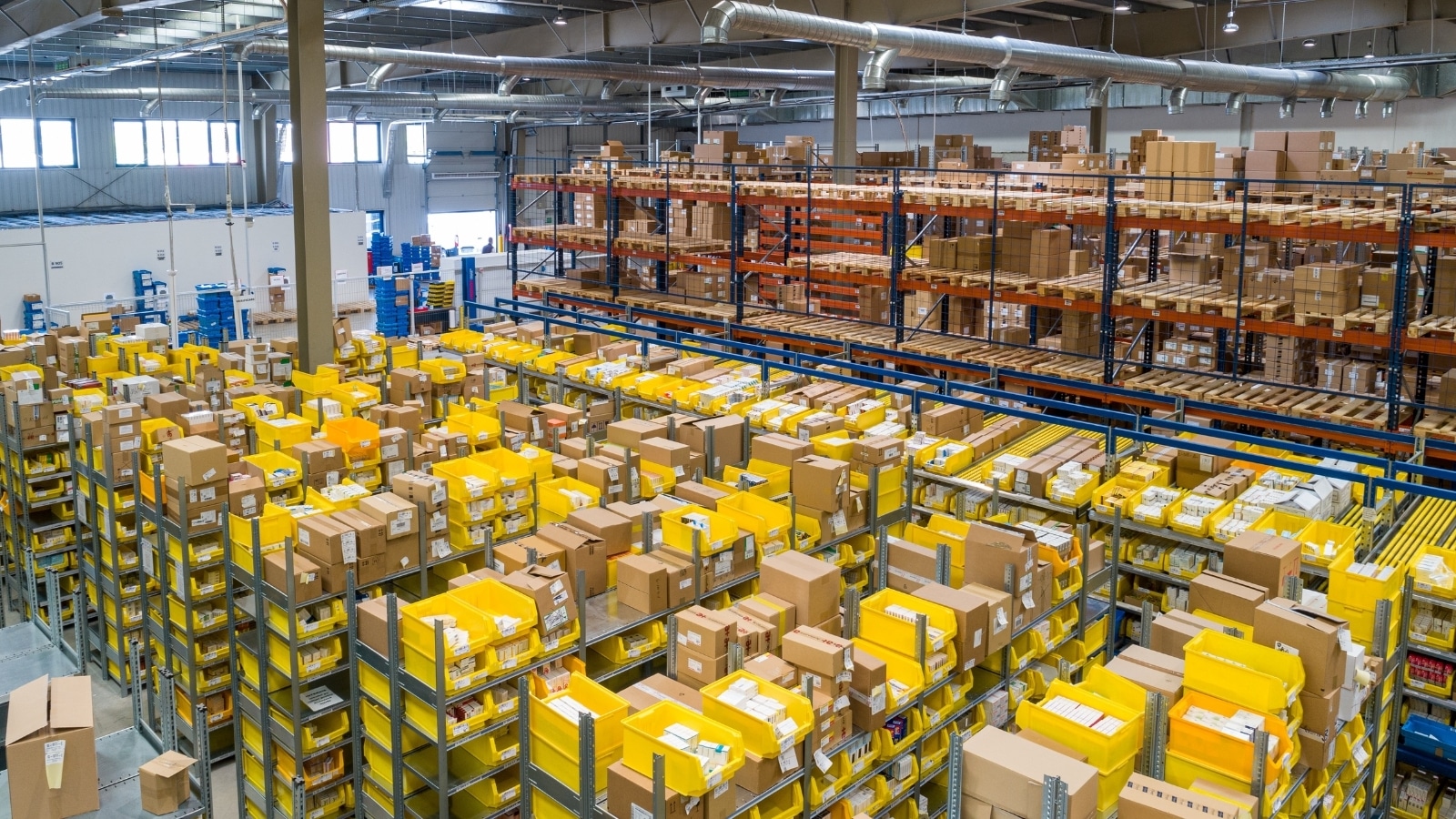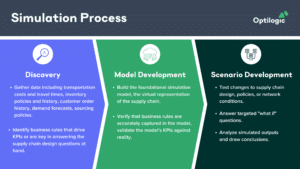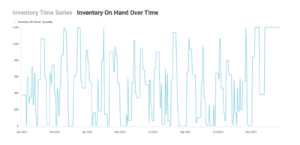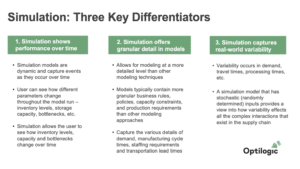
Supply chain simulation is the most granular modeling technique. This preferred method for service level analysis shows how business rules, policies, product requirements, etc. impact demand, manufacturing cycle times, staffing requirements, transportation lead times, and more. These insights can be instrumental for a multi-tiered supply chain’s inventory strategy.
Published by
Hannah Wilborn
Published on
October 1, 2024





Simulation is the most granular supply chain modeling technique. Simulation can be used to study how changes in business rules impact customer service, capacity and production requirements, inventory levels, lead times, and more.If you’re intimidated by the concept of simulation, we’ve got you covered. Read this supply chain simulation primer to learn the basics of simulation and how it brings unique value to strategic supply chain design.
-------------------------------------------------------
Supply chain simulation enables a realistic representation of the supply chain that can help businesses make intelligent, data-backed decisions to improve operations. Simulation enables businesses to conduct detailed tests of risk mitigation and network design improvement strategies in a low-stakes virtual environment. The simulation process relies on data collection, model and scenario development, test execution, and results analysis to bring the simulation results as close to the real-world supply chain as possible. Supply chain simulation models are unique in how deeply they understand the inner workings and behavior of the systems they are modeling. Simulation enables you to evaluate strategies for operating the system as it evolves over time. Incorporating random outlier events allows the system to predict and analyze inventory outages and overages, bottlenecks, bullwhip effects, etc. While often misconstrued, scenario modeling and simulation modeling are not synonymous. Simulations are dynamic models that capture system performance over time, tracking the interactions and dependencies between all elements of the system. Scenario modeling can be done under both simulation and other modeling methodologies; scenarios enable users to explore targeted “what if” questions and observe the impact of different network conditions, designs, or policies on cost, service, and other KPIs.

Businesses can use what-if scenario analysis in simulation to predict the impacts of change (within the control of the business or otherwise) and test strategies in a risk-free virtual environment. Here are some instances where implementing a simulation model can enable businesses to improve supply chain performance:
Supply chain simulation takes traditional inventory optimization to the next level. Organizations can use traditional network optimization to determine where stocking locations should be located throughout the network and identify average stocking levels by location-product. Simulation goes one step further by providing insights into how inventory levels change day by day under a given set of policies. A method called simulation-optimization can be used to generate policy recommendations that improve overall inventory health in the long term. Inventory simulation-optimization can consider an array of KPIs in addition to the aggregated cost analysis typically used as the objective in traditional optimization models. Often, we leverage the detailed service insights unique to simulation and seek out inventory policies that balance cost and service. Read more about how Optilogic leverages simulation for inventory optimization here.
Simulation-optimization seeks to improve supply chain performance by iteratively adjusting simulation model inputs, learning from the resulting model outputs, and using the best results to generate new combinations of inputs. This process is repeated many times, resulting in exploration of many simulation input configurations. Simulation enables a more accurate representation of the supply chain than traditional optimization, reducing abstraction in the inventory optimization process and providing modelers with detailed cost, service, and inventory level metrics to accompany inventory strategy recommendations.
Simulation models used for detailed testing of policies complement optimization in the design process, providing a clear understanding of how policy changes impact the end-to-end supply chain. A variety of policy types can be studied with simulation. Inventory Simulation provides an opportunity to experiment with inventory parameters like reorder points, reorder quantities or order-up-to levels, and inventory review periods, and observe impacts on inventory levels, cost, service, utilization, and more. Days of supply policies can be explored to capture dynamic inventory targets. Simulation-optimization can be used systematically to search for improved inventory policy parameters, but even a simple simulation model and a set of scenarios can lead to valuable inventory policy improvements.

Sourcing and Order Fulfillment Rather than viewing demand and product flow only in aggregate (e.g., monthly or annually), simulation executes logic to source and fulfill individual orders as they are placed over the model horizon. These policies are closely related to inventory in a simulation model. Order sourcing and fulfillment rules at both customer and replenishment levels are defined in a simulation model, enabling modelers to experiment with alternative structures and predict the impact on cost, service, and inventory levels. For more insights, check out this case study Mode Selection and Shipment-Building An additional benefit of the disaggregated nature of simulation is the ability to model and study the impacts of the logic used to build discrete shipments from orders. Transportation modes can be selected based on many factors, including the amount of product to be shipped and the due date of the shipment. Shipping frequency is another dial available to simulation modelers, enabling further control over consolidation of orders into shipments. Simulation outputs report individual shipments’ contents (orders, products, etc.), costs, and departure and arrival dates.
Before making a potentially disruptive decision to alter distribution channels or logistics partners, organizations can use simulation and scenario analysis to predict how the changes will impact the supply chain’s performance. This gives organizations the information necessary to make data-driven decisions, reduces risk, and facilitates smooth, informed transitions.
Businesses can use supply chain simulation to evaluate partner performance (supply variability, lead times, impact on downstream service) and identify areas for improvement. Simulating these scenarios enables businesses to make informed, objective decisions about which partners to utilize to avoid bottlenecks, mitigate risk, reduce cost, and improve customer satisfaction.
Demand variability has the potential to shake up complex supply chains. Simulation goes deeper than traditional demand sensitivity analysis, enabling users to observe many realizations of customer order behavior within the model’s horizon and study how the system responds to a variety of demand outcomes. This analysis can be informed by historical or projected customer ordering patterns.Considering demand uncertainty enables businesses to make more robust supply chain design and policy-setting decisions, supporting efforts including capacity and production planning, inventory policy setting, and contingency plan development.
When whispers of a potential supply chain disruption surface, organizations can run a simulation to understand how their supply chain will be impacted if the risk comes to fruition. Users can then prepare accordingly (rebalance inventory, secure additional capacity or storage, ramp up or slow down production, etc.) and create data-backed contingency plans. Identifying, quantifying, and mitigating risk is key to building resilience and increasing metrics like service levels and profit margins.
Supply chain simulation can support S&OP processes. Analysts can evaluate capacity, stocking, demand, and sourcing policy changes across time periods. The simulation helps users understand metrics like cost to serve, margin to serve, service metrics by customer, and utilization of storage sites, production lines, and other limited resources. Supply chain simulation leverages SKU-level and order-level details, offering valuable insights into key performance indicators (KPIs) for demand and supply scenarios commonly analyzed during Sales and Operations Planning (S&OP) processes.
Today’s industry leaders are realizing that supply chain network design processes should not exist apart from enterprise planning and execution systems. Recommendations identified via strategic network design simulation efforts can be more seamlessly transferred to planners and schedulers than results of other modeling methods due to simulation’s granular nature.Simulation enables supply chain designers to identify which elements of a design (inventory strategy changes, product launches, new site or supplier integration, altered transportation policies, etc.) should be implemented first for the best results. It shows how a new policy might affect planning and execution. Through this process, planners, managers, and executives can see the “to-be” state prior to implementation.
Supply chain simulation can identify inefficiencies and opportunities for improvement. By simulating the entire supply chain, organizations can predict bottlenecks, delays, and other inefficiencies that may impact performance. With this information, users can create strategies that mend the issue and create a more efficient supply chain. Simulation insights can also be used to inform scenarios explored in a prescriptive supply chain optimization study.Simulation more accurately indicates service metrics than optimization modeling alone. Combining detailed service metrics and financial performance data via simulation strengthens model output and the quality of resulting design decisions. Emphasizing service and considering demand variability in the design process enhances an organization’s ability to meet demand as uncertainty is realized and follow through on customer satisfaction promises.Using simulation to optimize inventory policies allows organizations to right-size inventory levels, while keeping cost and service in check.

Supply chain simulation enables organizations to increase their supply chain’s agility and resilience in the face of potential disruptions. Users can simulate potential disruptions, predict how the supply chain will react, and prepare or develop contingency plans accordingly. Disruptions are inevitable, but supply chain simulation enables organizations to mitigate the impact disruptions have on operations, customers, brand reputation, and the organization’s bottom line.
What-if scenario analysis in simulation allows users to test various alternative designs before carrying out any new plans. Unlike other modeling methods, simulation’s foundation is a detailed accounting of supply chain events (order handling, shipment-building, etc.). This, coupled with its unique ability to consider randomness in supply chain conditions, means simulation paints a more detailed picture of supply chain performance than other methods. Simulation arms modelers with deep insights and a wealth of data to use in decision-making.
Traditional supply chain optimization is a prescriptive modeling method that takes costs, demand requirements, alternative flow paths, facilities, and constraints (storage, inventory, sourcing, etc.) and determines the best (typically cost-optimal) network structure. This is the purpose of Cosmic Frog, Optilogic's supply chain design solution, which utilizes an advanced optimization engine to enhance supply chain performance. Simulation, on the other hand, is a descriptive method that predicts how the supply chain will respond to various conditions and policies, detailing how the supply chain operates and performs. Simulation results include detailed performance metrics, enabling modelers to answer “what if…” and “why” questions either about their current network, about proposed network designs, or in response to design recommendations prescribed by optimization. Cosmic Frog has a built-in simulation engine. Repeatedly adjusting simulation model inputs, running the simulation, and learning from results in an automated way is referred to as simulation-optimization. The foundation of this method is a working simulation model. Cosmic Frog’s inventory simulation engine is used to facilitate this type of analysis. When users can identify which policies are best and why that is the case, both the model and the analyst gain credibility. The resulting recommendations carry more weight, which can be powerful when implementing them requires persuasion.
Simulation is the most granular supply chain modeling technique. Simulation can be used to study how changes in business rules impact customer service, capacity and production requirements, inventory levels, lead times, and more.If you’re intimidated by the concept of simulation, we’ve got you covered. Read this supply chain simulation primer to learn the basics of simulation and how it brings unique value to strategic supply chain design.
-------------------------------------------------------
Supply chain simulation enables a realistic representation of the supply chain that can help businesses make intelligent, data-backed decisions to improve operations. Simulation enables businesses to conduct detailed tests of risk mitigation and network design improvement strategies in a low-stakes virtual environment. The simulation process relies on data collection, model and scenario development, test execution, and results analysis to bring the simulation results as close to the real-world supply chain as possible. Supply chain simulation models are unique in how deeply they understand the inner workings and behavior of the systems they are modeling. Simulation enables you to evaluate strategies for operating the system as it evolves over time. Incorporating random outlier events allows the system to predict and analyze inventory outages and overages, bottlenecks, bullwhip effects, etc. While often misconstrued, scenario modeling and simulation modeling are not synonymous. Simulations are dynamic models that capture system performance over time, tracking the interactions and dependencies between all elements of the system. Scenario modeling can be done under both simulation and other modeling methodologies; scenarios enable users to explore targeted “what if” questions and observe the impact of different network conditions, designs, or policies on cost, service, and other KPIs.

Businesses can use what-if scenario analysis in simulation to predict the impacts of change (within the control of the business or otherwise) and test strategies in a risk-free virtual environment. Here are some instances where implementing a simulation model can enable businesses to improve supply chain performance:
Supply chain simulation takes traditional inventory optimization to the next level. Organizations can use traditional network optimization to determine where stocking locations should be located throughout the network and identify average stocking levels by location-product. Simulation goes one step further by providing insights into how inventory levels change day by day under a given set of policies. A method called simulation-optimization can be used to generate policy recommendations that improve overall inventory health in the long term. Inventory simulation-optimization can consider an array of KPIs in addition to the aggregated cost analysis typically used as the objective in traditional optimization models. Often, we leverage the detailed service insights unique to simulation and seek out inventory policies that balance cost and service. Read more about how Optilogic leverages simulation for inventory optimization here.
Simulation-optimization seeks to improve supply chain performance by iteratively adjusting simulation model inputs, learning from the resulting model outputs, and using the best results to generate new combinations of inputs. This process is repeated many times, resulting in exploration of many simulation input configurations. Simulation enables a more accurate representation of the supply chain than traditional optimization, reducing abstraction in the inventory optimization process and providing modelers with detailed cost, service, and inventory level metrics to accompany inventory strategy recommendations.
Simulation models used for detailed testing of policies complement optimization in the design process, providing a clear understanding of how policy changes impact the end-to-end supply chain. A variety of policy types can be studied with simulation. Inventory Simulation provides an opportunity to experiment with inventory parameters like reorder points, reorder quantities or order-up-to levels, and inventory review periods, and observe impacts on inventory levels, cost, service, utilization, and more. Days of supply policies can be explored to capture dynamic inventory targets. Simulation-optimization can be used systematically to search for improved inventory policy parameters, but even a simple simulation model and a set of scenarios can lead to valuable inventory policy improvements.

Sourcing and Order Fulfillment Rather than viewing demand and product flow only in aggregate (e.g., monthly or annually), simulation executes logic to source and fulfill individual orders as they are placed over the model horizon. These policies are closely related to inventory in a simulation model. Order sourcing and fulfillment rules at both customer and replenishment levels are defined in a simulation model, enabling modelers to experiment with alternative structures and predict the impact on cost, service, and inventory levels. For more insights, check out this case study Mode Selection and Shipment-Building An additional benefit of the disaggregated nature of simulation is the ability to model and study the impacts of the logic used to build discrete shipments from orders. Transportation modes can be selected based on many factors, including the amount of product to be shipped and the due date of the shipment. Shipping frequency is another dial available to simulation modelers, enabling further control over consolidation of orders into shipments. Simulation outputs report individual shipments’ contents (orders, products, etc.), costs, and departure and arrival dates.
Before making a potentially disruptive decision to alter distribution channels or logistics partners, organizations can use simulation and scenario analysis to predict how the changes will impact the supply chain’s performance. This gives organizations the information necessary to make data-driven decisions, reduces risk, and facilitates smooth, informed transitions.
Businesses can use supply chain simulation to evaluate partner performance (supply variability, lead times, impact on downstream service) and identify areas for improvement. Simulating these scenarios enables businesses to make informed, objective decisions about which partners to utilize to avoid bottlenecks, mitigate risk, reduce cost, and improve customer satisfaction.
Demand variability has the potential to shake up complex supply chains. Simulation goes deeper than traditional demand sensitivity analysis, enabling users to observe many realizations of customer order behavior within the model’s horizon and study how the system responds to a variety of demand outcomes. This analysis can be informed by historical or projected customer ordering patterns.Considering demand uncertainty enables businesses to make more robust supply chain design and policy-setting decisions, supporting efforts including capacity and production planning, inventory policy setting, and contingency plan development.
When whispers of a potential supply chain disruption surface, organizations can run a simulation to understand how their supply chain will be impacted if the risk comes to fruition. Users can then prepare accordingly (rebalance inventory, secure additional capacity or storage, ramp up or slow down production, etc.) and create data-backed contingency plans. Identifying, quantifying, and mitigating risk is key to building resilience and increasing metrics like service levels and profit margins.
Supply chain simulation can support S&OP processes. Analysts can evaluate capacity, stocking, demand, and sourcing policy changes across time periods. The simulation helps users understand metrics like cost to serve, margin to serve, service metrics by customer, and utilization of storage sites, production lines, and other limited resources. Supply chain simulation leverages SKU-level and order-level details, offering valuable insights into key performance indicators (KPIs) for demand and supply scenarios commonly analyzed during Sales and Operations Planning (S&OP) processes.
Today’s industry leaders are realizing that supply chain network design processes should not exist apart from enterprise planning and execution systems. Recommendations identified via strategic network design simulation efforts can be more seamlessly transferred to planners and schedulers than results of other modeling methods due to simulation’s granular nature.Simulation enables supply chain designers to identify which elements of a design (inventory strategy changes, product launches, new site or supplier integration, altered transportation policies, etc.) should be implemented first for the best results. It shows how a new policy might affect planning and execution. Through this process, planners, managers, and executives can see the “to-be” state prior to implementation.
Supply chain simulation can identify inefficiencies and opportunities for improvement. By simulating the entire supply chain, organizations can predict bottlenecks, delays, and other inefficiencies that may impact performance. With this information, users can create strategies that mend the issue and create a more efficient supply chain. Simulation insights can also be used to inform scenarios explored in a prescriptive supply chain optimization study.Simulation more accurately indicates service metrics than optimization modeling alone. Combining detailed service metrics and financial performance data via simulation strengthens model output and the quality of resulting design decisions. Emphasizing service and considering demand variability in the design process enhances an organization’s ability to meet demand as uncertainty is realized and follow through on customer satisfaction promises.Using simulation to optimize inventory policies allows organizations to right-size inventory levels, while keeping cost and service in check.

Supply chain simulation enables organizations to increase their supply chain’s agility and resilience in the face of potential disruptions. Users can simulate potential disruptions, predict how the supply chain will react, and prepare or develop contingency plans accordingly. Disruptions are inevitable, but supply chain simulation enables organizations to mitigate the impact disruptions have on operations, customers, brand reputation, and the organization’s bottom line.
What-if scenario analysis in simulation allows users to test various alternative designs before carrying out any new plans. Unlike other modeling methods, simulation’s foundation is a detailed accounting of supply chain events (order handling, shipment-building, etc.). This, coupled with its unique ability to consider randomness in supply chain conditions, means simulation paints a more detailed picture of supply chain performance than other methods. Simulation arms modelers with deep insights and a wealth of data to use in decision-making.
Traditional supply chain optimization is a prescriptive modeling method that takes costs, demand requirements, alternative flow paths, facilities, and constraints (storage, inventory, sourcing, etc.) and determines the best (typically cost-optimal) network structure. This is the purpose of Cosmic Frog, Optilogic's supply chain design solution, which utilizes an advanced optimization engine to enhance supply chain performance. Simulation, on the other hand, is a descriptive method that predicts how the supply chain will respond to various conditions and policies, detailing how the supply chain operates and performs. Simulation results include detailed performance metrics, enabling modelers to answer “what if…” and “why” questions either about their current network, about proposed network designs, or in response to design recommendations prescribed by optimization. Cosmic Frog has a built-in simulation engine. Repeatedly adjusting simulation model inputs, running the simulation, and learning from results in an automated way is referred to as simulation-optimization. The foundation of this method is a working simulation model. Cosmic Frog’s inventory simulation engine is used to facilitate this type of analysis. When users can identify which policies are best and why that is the case, both the model and the analyst gain credibility. The resulting recommendations carry more weight, which can be powerful when implementing them requires persuasion.
Fill out the form to unlock the full content

.png)

.png)